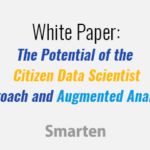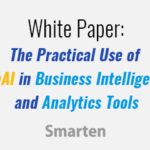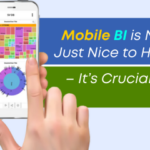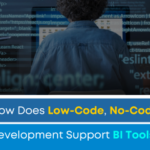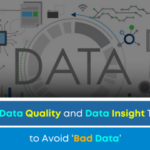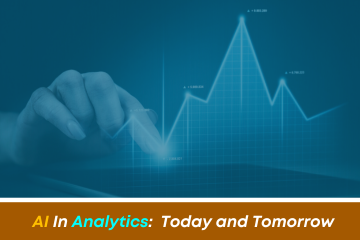
Nothing…and I DO mean NOTHING…is more prominent in technology buzz today than Artificial Intelligence (AI). The use of Generative AI, LLM and products such as ChatGPT capabilities has been applied to all kinds of industries, from publishing and research to targeted marketing and healthcare. Gartner recently estimated that the market for AI software will be nearly $134.8 billion, with the market growing by 31.1% in next several years. In a recent survey of C-suite executives, 80% of said they believe AI will transform their organizations, and 64% said it is the most transformational technology in a generation.
In this article, we will discuss the current state of AI in analytics, as well as the future of this burgeoning industry and how it can be applied to analytics to simplify and clarify results and to make analytics easier for businesses and business users to leverage.
But before we dive into the future of AI, let’s define a few terms:
- Generative Artificial Intelligence (AI) – A branch of computer science, involving unsupervised and semi-supervised algorithms that allow a system to create content in response to prompts, by repurposing and translating content from text, audio, images and code.
- OpenAI – Azure OpenAI as the foundational entity for creating GPT models and is based on Large Language Models (LLM). Open AI was developed by Microsoft. Competitive products include GPT J, Gork and BARD/GEMINI, developed by Google.
- GPT – Is based on a Large Language Model (LLM). As the foundation for ChatGPT and other developed solutions, GPT can be used for a wide range of tasks and is well-suited for language translation and content creation (as opposed to content repurposing). Benefits include customized and optimized models, data, parameters and tuning. This technology can be a valuable tool to automate functions and to generate ideas.
- Chat Generative Pretrained Transformer (ChatGPT) – ChatGPT is a transformer, based on GPT. This is the most talked-about offering on the market today. It is specifically designed for chatbot applications. This is a commercial, service-based GPT Chat Bot solution, designed to automate routine tasks and enhance communications to improve customer support and create marketing campaigns.
- Prompt Engineering – This toolbox includes tools to create, tune and evaluate prompts for input and output. It must be integrated with business systems to leverage available data. This approach does demand skills, data curation, and significant funding, but it will serve the market for third-party, specialized models.
Today’s AI models have not reached their true potential and, as these models and products evolve, businesses will undoubtedly embrace the tools to enable productivity, optimize business results and resources and design and implement targeted approaches to personalize outreach to customers, patients, students, and others.
The Current State of AI in Analytics
By combining machine learning with AI, analytics vendors can and have made strides in providing user-friendly, self-serve augmented analytics products that include the newest versions of these technologies:
- Machine Learning (ML)
- Generative Artificial Intelligence (GenAI)
- Deep Learning
- Natural Language Processing (NLP)
- Advanced Data Processing including Soundex, FTA, SMOTE
- A Wealth of Statistics, Algorithms and Hypothesis Testing Techniques
Artificial Intelligence (AI) and Machine Learning (ML) elements are embedded within the platform to support Citizen Data Scientists and help users prepare data, achieve automated data insights and create, share and use predictive models.
- Automatic narration generation for any report, visualization, and interpretation generation for various models and insights
- Natural Language Processing (NLP) driven queries on datasets, to reveal context such as seasons, polarity, ranking, festivals, holidays, trends and many other aspects of natural queries
- Auto-recommendation of target column from the dataset
- Predictors impact on target column
- Recommendation of optimal predictor values based on target for prescription
- Auto-recommendation of best-fit algorithms
- Data quality observations including correlation and associations within datasets
- Automation and recommendations for Data Preparation: JOINs, Sampling, Outliers, Clustering, Semantic Datatype Identification, Similar Sounding Data Value Identification, Other Features for Data Preparation.
- Key Influencer Analytics to understand interrelationships and impact of data columns with each other and target columns
- Sentiment Analysis This sophisticated analytical technique goes beyond quantitative questionnaires and surveys to capture the real opinions, feelings and sentiments of consumers, employees, and other stakeholders.
- Anomaly Alerts KPI monitoring and Auto Insights allows business users to quickly establish KPIs and target metrics and identify the Key Influencers and variables for the target KPI.
- Assisted Predictive Modeling and Auto Insights to create predictive models using self-guiding UI wizard and auto-recommendations
The Future of AI in Analytics
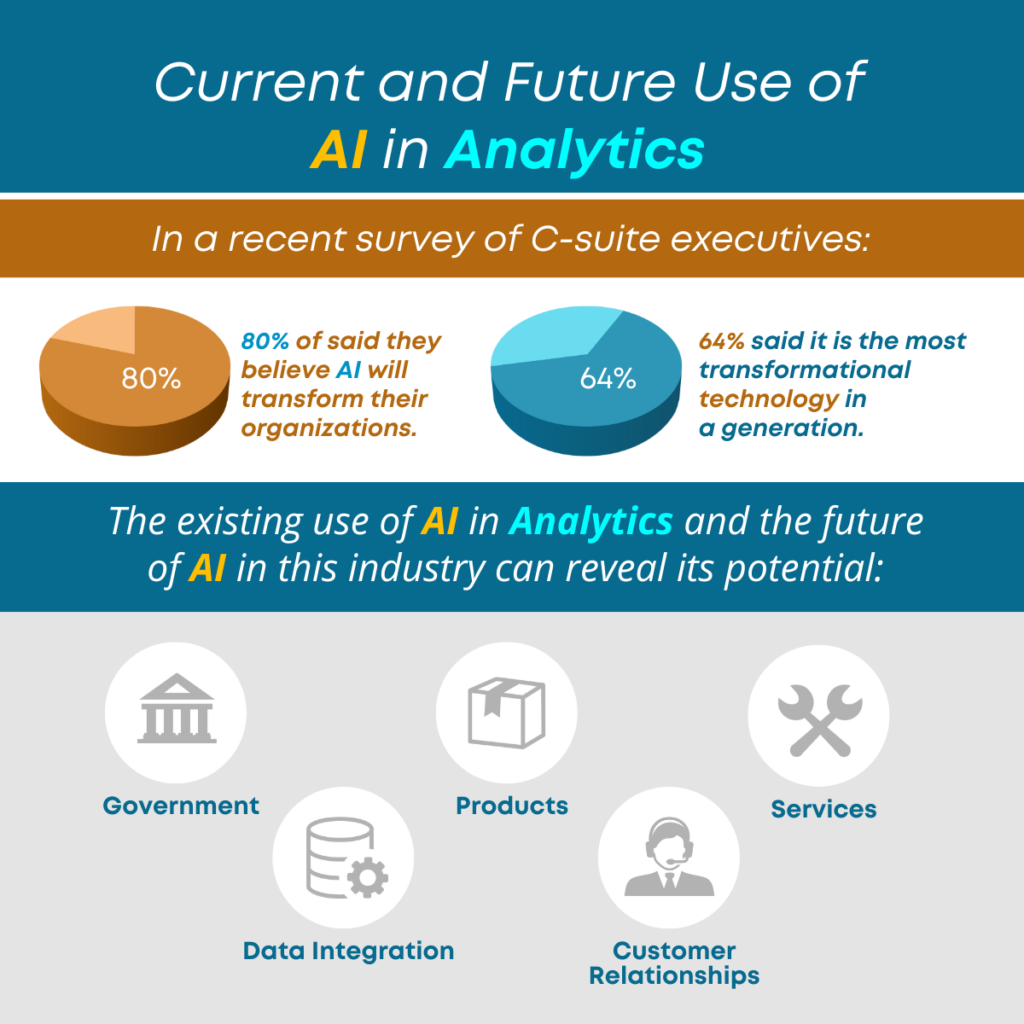
The C=suite executive survey revealed that 93% felt that data strategy is critical to getting value from generative AI, but a full 57% had made no changes to their data. In order to get the most out of AI, businesses will have to look carefully at their technology landscape and will have to change the business culture and business processes. The value of an AI-focused analytics solution can only be fully realized when a business has ensured data quality and integration of data sources, so it will be important for businesses to choose an analytics solution and service provider that can help them achieve these goals.
As businesses work toward these goals, the use of systems monitors will become more important. Systems monitors track the statues of learning models to ensure that the model predictions are accurate and identify where the models must be trained with additional or new data.
The use and reuse of datasets, models, variables, targets and features will be important to the training of these models. Now, and for the foreseeable future, AI depends heavily on ‘training’ a model to understand historical data and other factors and use that to predict outcomes and deliver information.
Vendors, service providers and analytics solution companies will package data products and design data management solutions to support business users in their interaction with suppliers, customers and stakeholders, and to inform and support customers and end users as they choose products and options. Price and bundling optimization, demand pricing, and other variables will be included to provide the best options, prices and responses and to personalize the approach and present results for data analysis and for end users. The goal will be to optimize business resources (materials, staff, time and investments) and to produce high-quality, customer-centric responses, products and services.
The impact of evolving AI within analytics will also influence how the business organization uses its human resources. Data Scientists and related positions will shift to support the use of AI in a strategic environment, and to manage data, models, connectors and translators. Data Product Managers will oversee the process and ensure that data model creation is appropriate. Chief Information Officers will evolve, and additional roles may be added to accommodate digital technology and AI, with appropriate skills to lead a new, more technology-oriented organization.
Examples of Future AI Analytics
Government – Climate, environmental and social issues can be analyzed to address preferences and inefficiencies and to more accurately predict infrastructure, weather and voting outcomes.
Products – Manufacturers can analyze safety issues, and customer preferences and shift and change products and services accordingly.
Services – Utility companies can identify usage patterns, and inefficiencies and plan to optimize consumption during peak periods, and to create new locations and infrastructure to serve expanding communities.
Data Integration – Businesses can incorporate storage and data security services and infrastructure, thereby making it easier to avoid data silos and to achieve data integration and single-point-of-contact data analytics. By unifying data across the enterprise, the business can save money and resources and enable use of data for analysis without cumbersome manual data gathering and manual integration.
Customer Relationships – The Use of AI to optimize customer experiences and enhance personalization and outreach will improve business results and streamline the organization and the roles of team members.
As we have outlined in this article, it is important to recognize that your business can and should leverage the existing capabilities of Artificial Intelligence (AI) today. The promise of AI will continue to evolve, and there is no telling where it can go. As it is applied to analytics, vendors must carefully assess its progress and ensure that analytical solutions do not place more dependence on its potential before that potential has been thoroughly developed. Be sure you select an analytics service provider and IT consultant that has a clear roadmap and plan to leverage AI only as and when the foundation has been proven, so you can confidently use the analytics solution and the results it provides. Be sure you choose a vendor with comprehensive augmented analytics features and functionality designed specifically for business users, to support the transition of your business users to Citizen Data Scientists and ensure that your project will succeed. Contact Us to find out how we can help you plan and achieve your goals.
Original Post : Current and Future Use of AI in Analytics!



